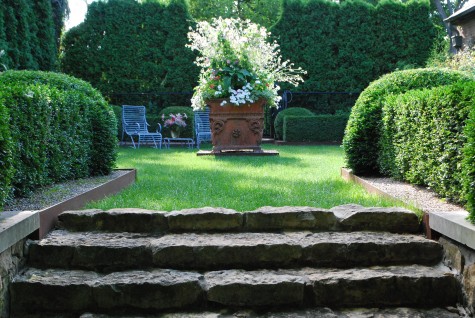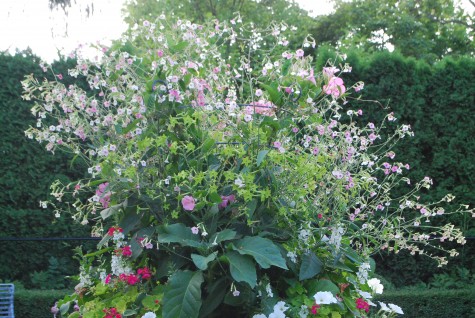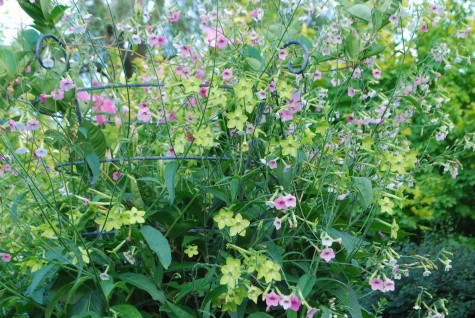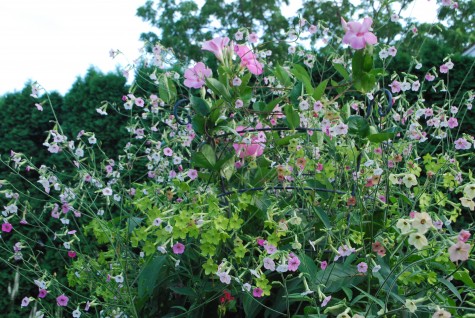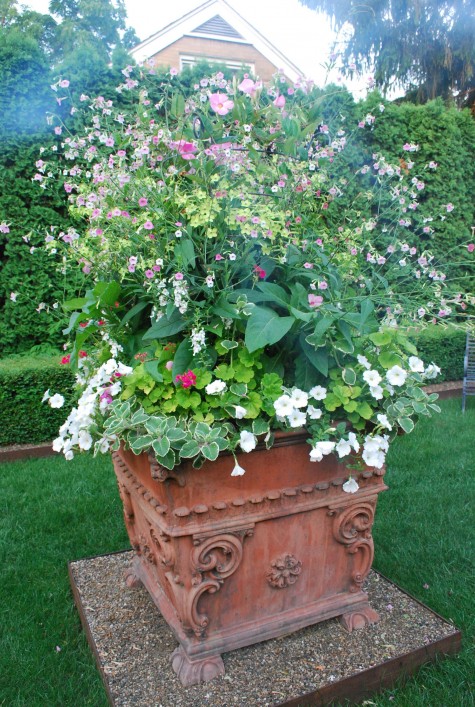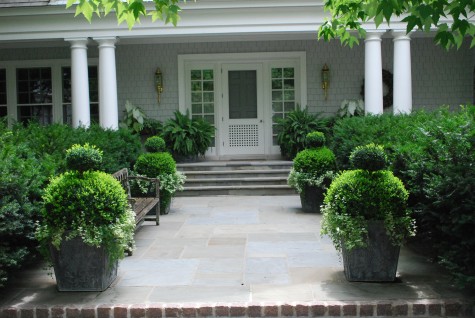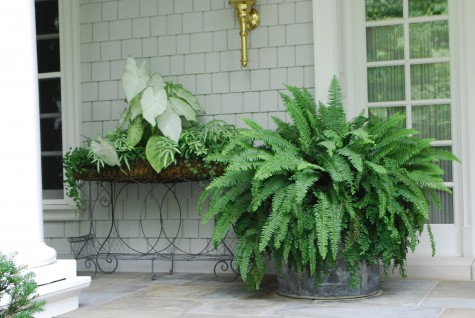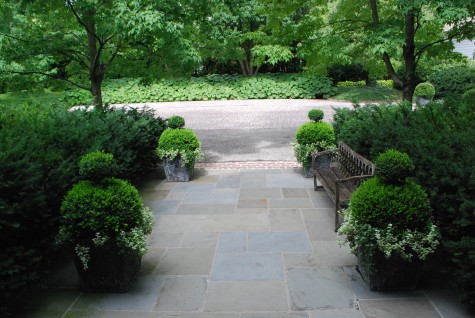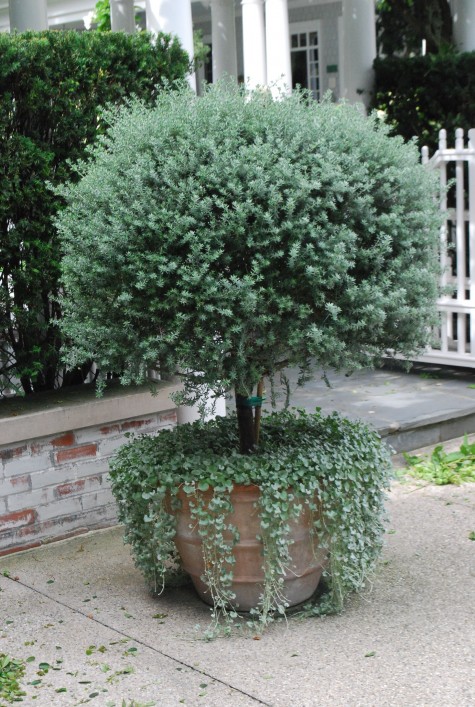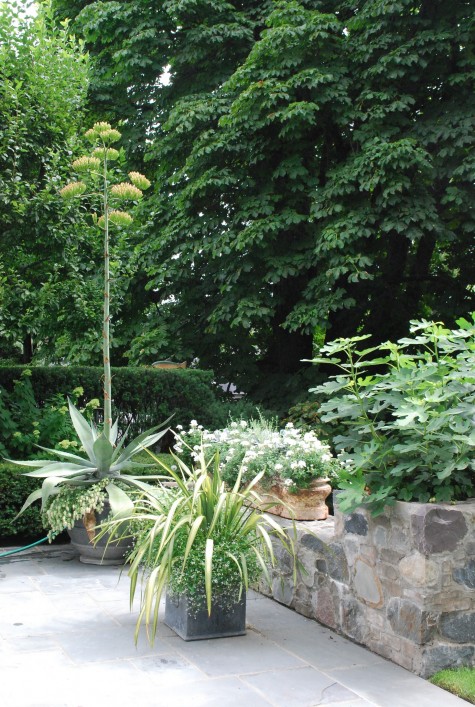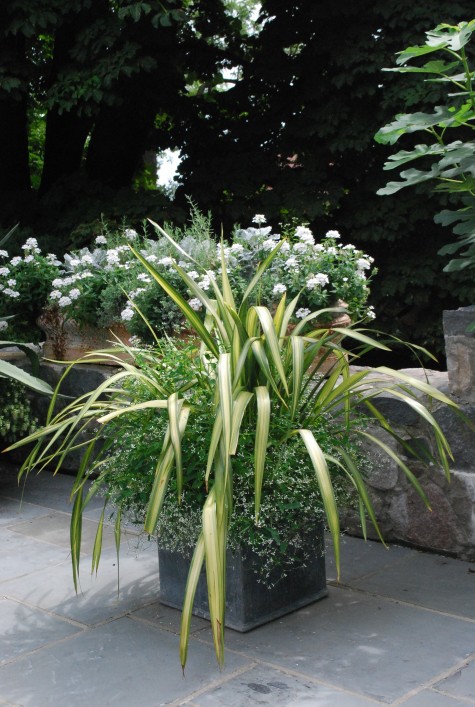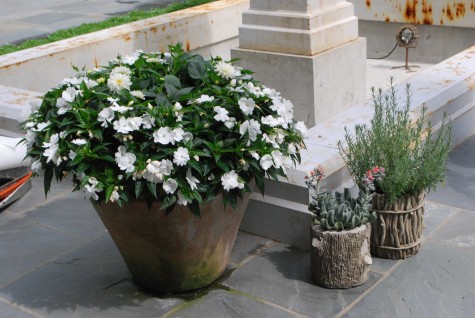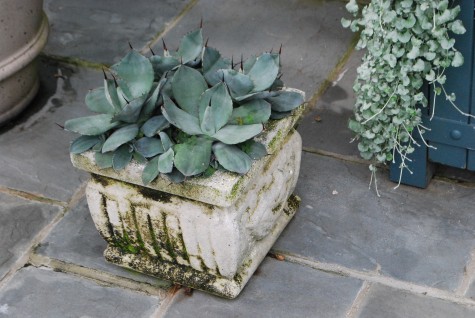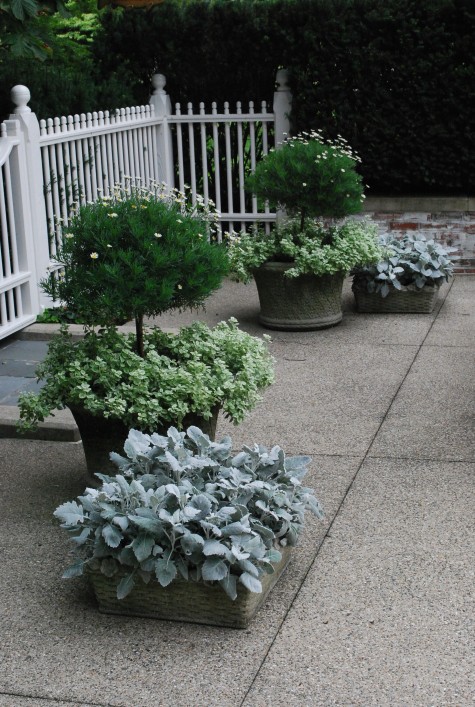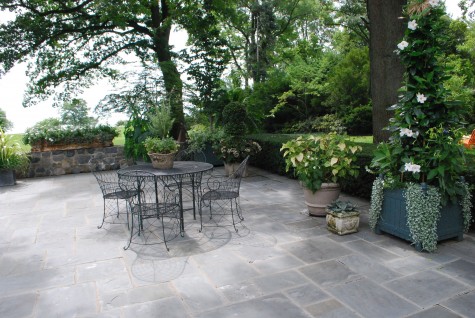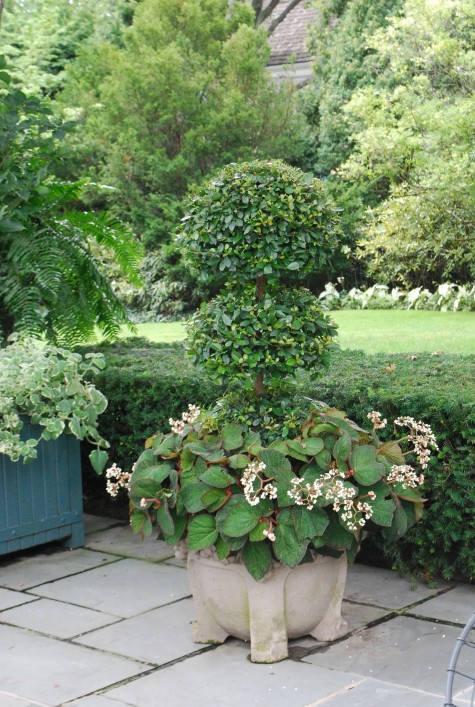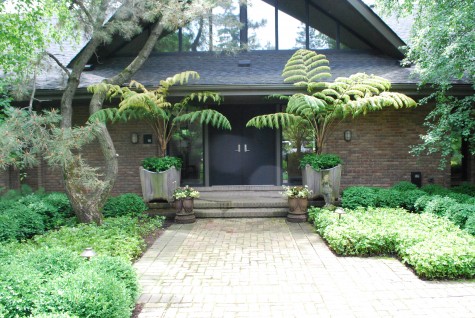 I have my favorite places. What makes for a favorite place? A client with an eye for beauty and a committment to the garden. A client who is always willing to try something new. That said, an ancient and sparsely foliated scotch pine flanks the front door-Mr. will not now, and not ever, let me touch it. This too makes for a favorite place-strong feelings. The Australian tree ferns I have wintered in a greenhouse for them for about 10 years. We cut them back to the main trunk in the fall. By spring they are leafing out vigorously. This year I underplanted them thickly with maidenhair ferns.
I have my favorite places. What makes for a favorite place? A client with an eye for beauty and a committment to the garden. A client who is always willing to try something new. That said, an ancient and sparsely foliated scotch pine flanks the front door-Mr. will not now, and not ever, let me touch it. This too makes for a favorite place-strong feelings. The Australian tree ferns I have wintered in a greenhouse for them for about 10 years. We cut them back to the main trunk in the fall. By spring they are leafing out vigorously. This year I underplanted them thickly with maidenhair ferns.
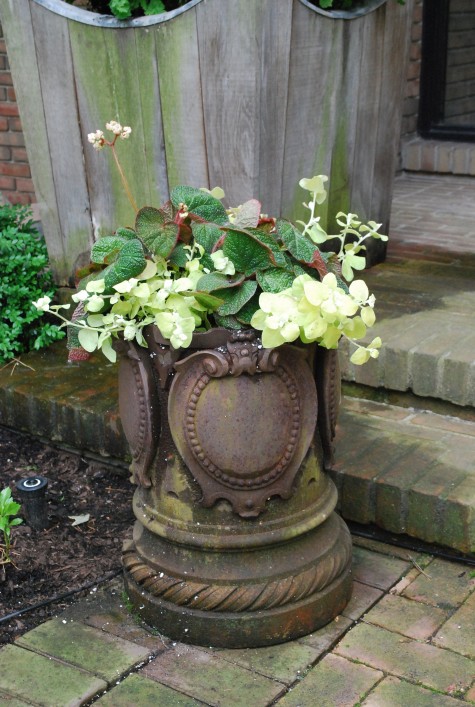 A pair of chimney pots got planted with an unknown begonia-I like the leaves. The rusty colored hairs on the stems and backsides of the leaves look great with the rusty brown pots. Lime licorice grows anywhere for me-sun or shade. That pale chartreuse color will highlight those deep green leaves.
A pair of chimney pots got planted with an unknown begonia-I like the leaves. The rusty colored hairs on the stems and backsides of the leaves look great with the rusty brown pots. Lime licorice grows anywhere for me-sun or shade. That pale chartreuse color will highlight those deep green leaves.
 Planting day was a sunny day-so my pictures are not very good. A lime, lavender, purple and yellow color scheme is enlivened with an occasion burgundy potunia-just for emphasis. Vinca maculatum will trail dowen long on the far side, as will the misty lilac wave petunias.
Planting day was a sunny day-so my pictures are not very good. A lime, lavender, purple and yellow color scheme is enlivened with an occasion burgundy potunia-just for emphasis. Vinca maculatum will trail dowen long on the far side, as will the misty lilac wave petunias.
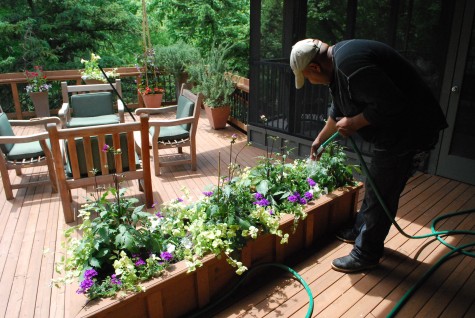 The small box got cactus flowered purple dahlias, purple angelonia (new this year) lanai blue trailing verbena, white petunias and lime licorice.
The small box got cactus flowered purple dahlias, purple angelonia (new this year) lanai blue trailing verbena, white petunias and lime licorice.
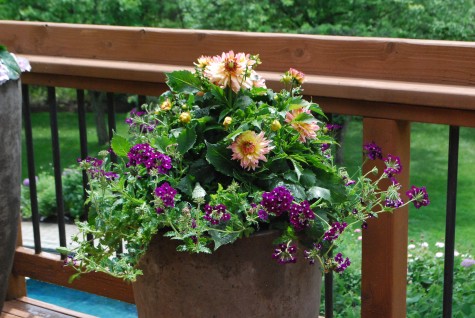 A pot nearby has a yellow and peach bicolor dahlia, and a skirt of dark red violet trailing verbena. I like the forms of the plants together as much as I like the color. I like the contrast of the big dahlia leaves to the slight-sized verbena leaves. Plants have visual relationships on a lot of levels.
A pot nearby has a yellow and peach bicolor dahlia, and a skirt of dark red violet trailing verbena. I like the forms of the plants together as much as I like the color. I like the contrast of the big dahlia leaves to the slight-sized verbena leaves. Plants have visual relationships on a lot of levels.
 The centerpiece of this pot is a double (also known as hose in hose) datura. I caution anyone who grows them-every part of a datura is poisonous. The plants smell poisonous. If you cultivate this beauty, wash your hands after you touch it. Beyond the warning label lies a gorgeous big leaved plant with giant flowers. A diminuitive white and lavender veined mini petunia against lime licorice is a cooly tart, and small textured mix. The datura will be the star of the show.
The centerpiece of this pot is a double (also known as hose in hose) datura. I caution anyone who grows them-every part of a datura is poisonous. The plants smell poisonous. If you cultivate this beauty, wash your hands after you touch it. Beyond the warning label lies a gorgeous big leaved plant with giant flowers. A diminuitive white and lavender veined mini petunia against lime licorice is a cooly tart, and small textured mix. The datura will be the star of the show.
 The perennial garden at the pool is just coming to life. The peonies are out, and the roses are not far behind. The purple alliums show well from the second floor deck; this is a garden primarily viewed from above. We add some nicotiana and verbena bonariensis between the tall perennials, and plant an annual border to soften the edge of the pool brick. This year, showy oregano, appleblossom petunias and heliotrope will fill in and cover the soil.
The perennial garden at the pool is just coming to life. The peonies are out, and the roses are not far behind. The purple alliums show well from the second floor deck; this is a garden primarily viewed from above. We add some nicotiana and verbena bonariensis between the tall perennials, and plant an annual border to soften the edge of the pool brick. This year, showy oregano, appleblossom petunias and heliotrope will fill in and cover the soil.
 When my client asks for herb pots, she is really asking for basil pots. I did a pair. Leeks in the middle, and everbearing strawberries with pink flowers at the corners. Lots and lots of basil. This I understand. Its pungent smell and taste-irresistable.
When my client asks for herb pots, she is really asking for basil pots. I did a pair. Leeks in the middle, and everbearing strawberries with pink flowers at the corners. Lots and lots of basil. This I understand. Its pungent smell and taste-irresistable.
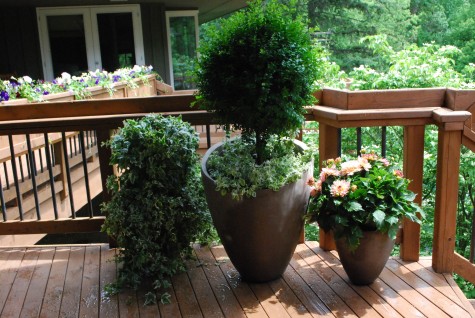 This trio of pots feature an old variegated ivy topiary, and a single ball boxwood topiary. The boxwood got an underplanting of variegated licorice; the third pot is stuffed with a dahlia. The pots are from Francesca del Re in Italy. The are very simple, handsome, and frostproof. The clay is so loaded with minerals that the pots are very strong. We make sure no water collects in them over the winter. Freezing water expands as it becomes ice-this process can damage pots. These terra cotta pots have been outside for a good many years.
This trio of pots feature an old variegated ivy topiary, and a single ball boxwood topiary. The boxwood got an underplanting of variegated licorice; the third pot is stuffed with a dahlia. The pots are from Francesca del Re in Italy. The are very simple, handsome, and frostproof. The clay is so loaded with minerals that the pots are very strong. We make sure no water collects in them over the winter. Freezing water expands as it becomes ice-this process can damage pots. These terra cotta pots have been outside for a good many years.
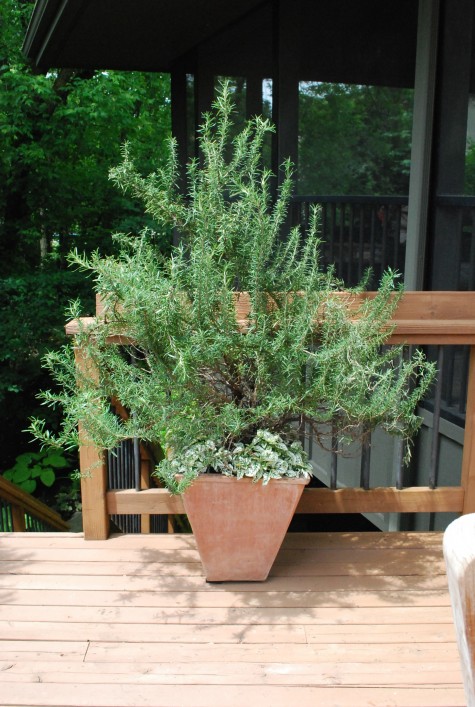 This wildly natural rosemary has belonged to my client a long time. The only thing we prune is the rootball; this plant has a life of its own going on. This year, we underplanted it with white polka dot plant-I think I am going to like this.
This wildly natural rosemary has belonged to my client a long time. The only thing we prune is the rootball; this plant has a life of its own going on. This year, we underplanted it with white polka dot plant-I think I am going to like this.
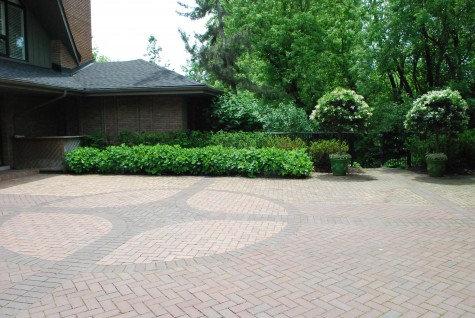
My first project with this client many years ago involved digging up every plant she had, and rearranging. This took 2 days. There were lots of projects after this-not the least of which was the most romantic garden wedding I have ever been involved with. My client-she drove that bus. The story of the driveway? The drive needed to be enlarged; the original brick was no longer available. We took up all of the old brick, and reused it with a new brick in an entirely different pattern. All of the pale brick you see here is original. The two colors of dark brick are new. It looks entirely believable; the mix of old and new reads as one thought. The 12 year old waxleaf privet topiaries got planted back in their summer home-they are just about to bloom. Most every bit of this garden-swell.
